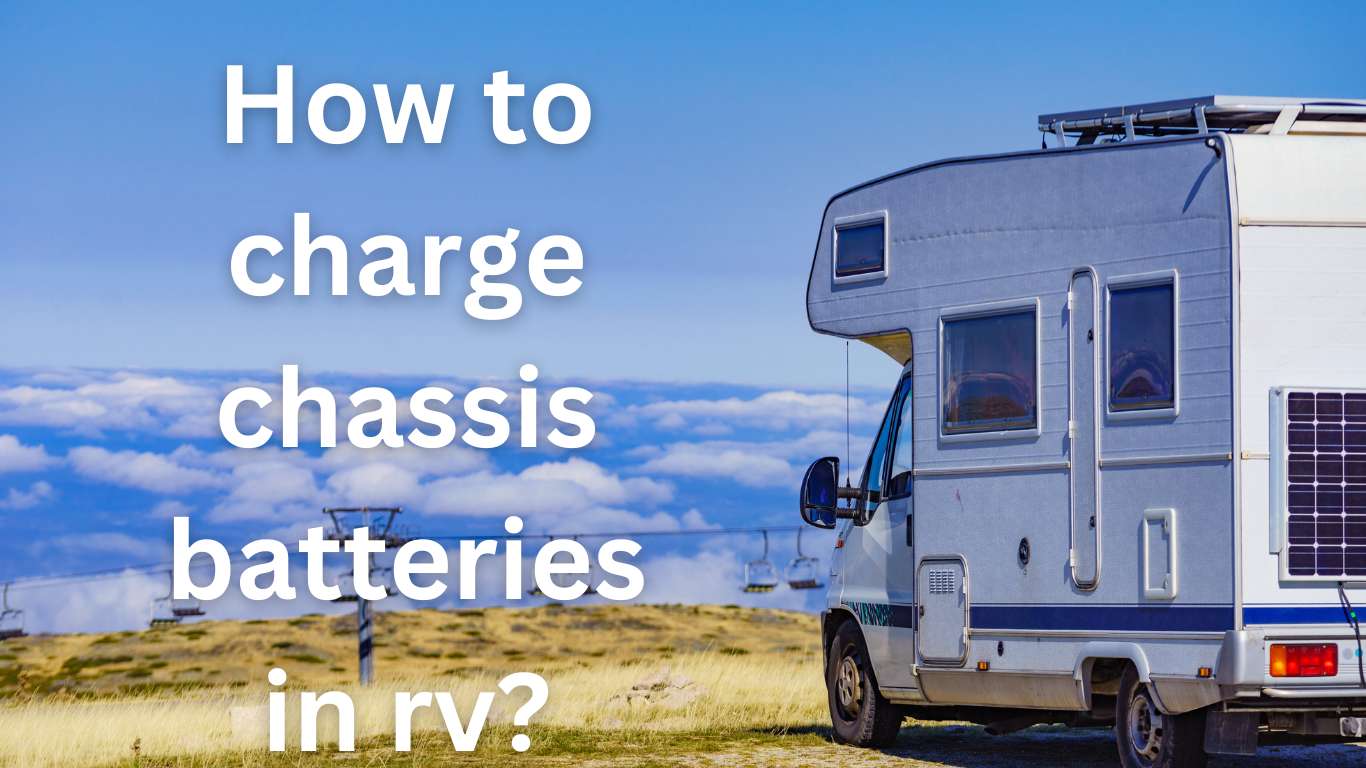Chassis batteries, also known as starting batteries, are essential for powering your RV’s engine and related systems like headlights and dashboard electronics. Knowing how to charge them properly ensures reliable performance and avoids unnecessary breakdowns. Let’s explore the best ways to charge your chassis batteries and maintain their health. Learn how to charge chassis batteries in an RV with simple methods like using the alternator, shore power, or a dedicated battery charger. Ensure your RV’s chassis battery stays reliable for every trip.
Methods to Charge Chassis Batteries in an RV
Using the RV’s Alternator
The most common way to charge chassis batteries is through the RV’s alternator while driving.
- How It Works: When the engine runs, the alternator generates electricity to recharge the chassis battery.
- Best For: Daily travelers and road trips.
Connecting to Shore Power
When plugged into shore power at a campsite, your RV’s converter or inverter/charger may also charge the chassis battery.
- Tip: Not all RVs have a built-in feature to charge chassis batteries from shore power. If yours doesn’t, you may need a battery isolator or a DC-to-DC charger to enable this functionality.
Using a Battery Charger
A dedicated battery charger is a reliable option for charging chassis batteries.
- How to Use:
- Disconnect the battery cables to avoid overloading the electrical system.
- Connect the charger clamps to the battery terminals (red to positive, black to negative).
- Set the charger to the appropriate voltage (typically 12 volts).
- Plug in the charger and monitor the process.
- Best For: Long-term storage or when the alternator isn’t sufficient.
Solar Panels with a Charge Controller
Solar panels can charge chassis batteries when paired with a charge controller.
- Advantages: Eco-friendly and ideal for off-grid camping.
- Tip: Ensure your solar system is configured to charge both house and chassis batteries.
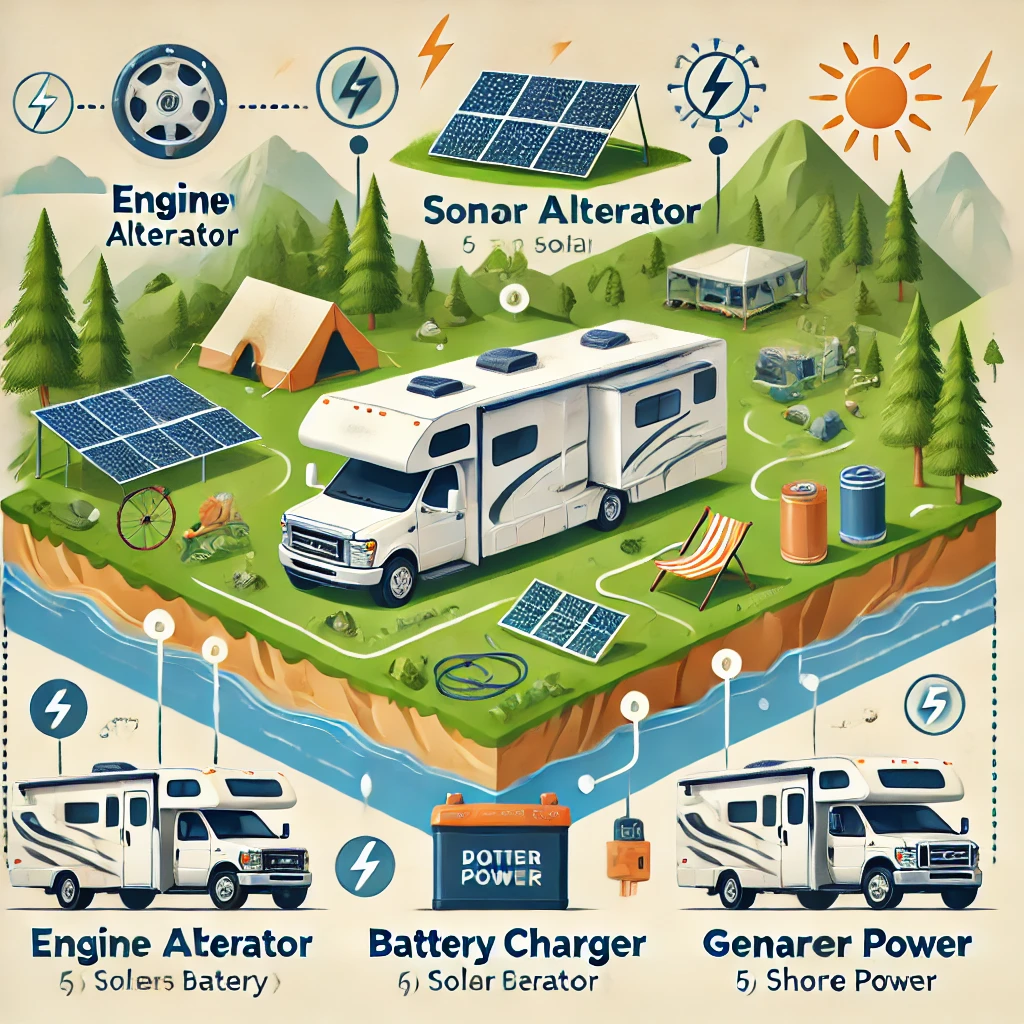
Tips for Charging Chassis Batteries Safely
Regularly Check Voltage Levels
Use a multimeter to ensure the battery is charging properly. A fully charged chassis battery typically reads 12.6 to 12.8 volts.
Avoid Overcharging
Overcharging can damage the battery. Use a smart charger that automatically shuts off when the battery is full.
Maintain Battery Terminals
Keep terminals clean and free of corrosion to ensure efficient charging and electrical flow.
How RV Batteries Work: A Complete Guide
RV batteries are the lifeblood of your motorhome or camper, powering everything from lights and appliances to your water pump. Understanding how RV batteries work is essential for enjoying worry-free adventures and keeping your rig’s systems running smoothly.
The Basics of RV Battery Operation
An RV battery stores energy in chemical form and converts it into electricity to power your RV’s systems. Most RVs use 12-volt batteries, either as lead-acid or lithium-ion types. These batteries supply direct current (DC) to your appliances, ensuring off-grid functionality.
Lead-Acid vs. Lithium-Ion Batteries
- Lead-Acid Batteries:
- Affordable and widely available.
- Require regular maintenance (checking water levels and preventing sulfation).
- Heavier and less efficient than modern alternatives.
- Lithium-Ion Batteries:
- Lightweight, durable, and highly efficient.
- Provide longer life cycles and quicker charging.
- Costlier upfront but offer long-term savings.
How Batteries Charge in an RV
- Shore Power: When connected to a campsite, your RV’s converter charges the batteries.
- Solar Panels: A sustainable option that uses sunlight to recharge.
- Generator: An alternative when off-grid to keep batteries charged.
- Alternator: Your engine charges the house battery while driving.
Factors Affecting RV Battery Performance
Several factors influence how well your RV battery performs, such as temperature, age, and usage. Proper maintenance is crucial for optimal performance.
Tips for Prolonging Battery Life
- Keep the battery charged but avoid overcharging.
- Regularly clean terminals to prevent corrosion.
- Use a battery monitor to track charge levels.
What Type of Battery Is Used in an RV?
Choosing the right battery for your RV is crucial for powering your adventures. RVs primarily use deep cycle batteries, designed to deliver consistent power over an extended period. Let’s explore the common types of RV batteries and their unique features to help you make the best choice.
Types of Batteries Used in RVs
RVs rely on different types of batteries, each suited for specific needs. These include lead-acid, lithium-ion, and AGM batteries. Here’s a closer look:
Lead-Acid Batteries
Lead-acid batteries are the traditional choice for RVs, known for their affordability and reliability.
- Flooded Lead-Acid Batteries: Require regular maintenance, such as adding distilled water and cleaning terminals.
- Sealed Lead-Acid Batteries: Low maintenance but slightly more expensive.
Lithium-Ion Batteries
Lithium-ion batteries are rapidly becoming the top choice for RV enthusiasts.
- Lightweight and compact design.
- Provide a longer lifespan (up to 10 years).
- Faster charging and higher efficiency.
- Ideal for solar setups and frequent boondocking.
AGM (Absorbent Glass Mat) Batteries
AGM batteries are a type of sealed lead-acid battery with advanced technology.
- Maintenance-free and spill-proof.
- Better performance in extreme temperatures.
- Shorter lifespan compared to lithium-ion but more affordable.
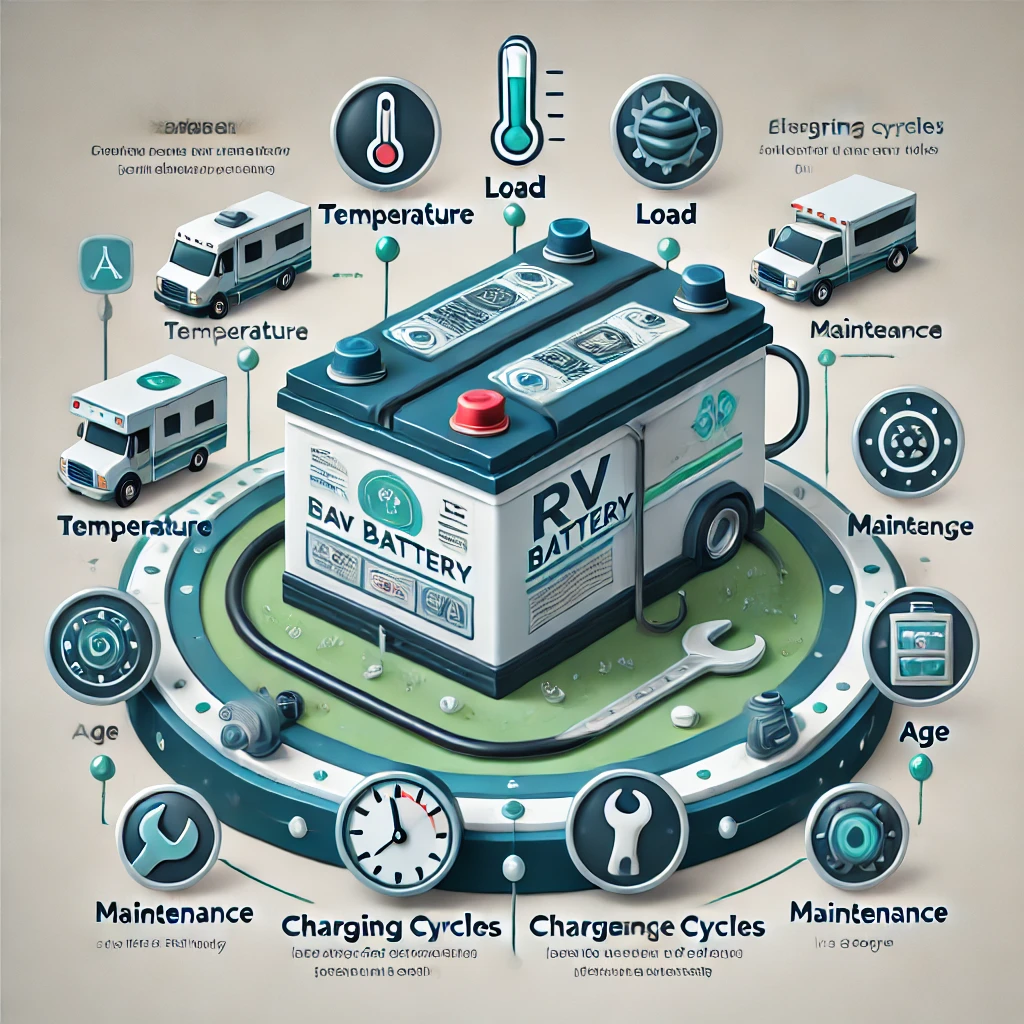
How to Choose the Right Battery for Your RV
Selecting the right RV battery depends on your camping style, budget, and power needs.
Factors to Consider
- Power Requirements: Calculate your daily energy usage to find the right capacity.
- Weight and Space: Lithium-ion batteries are lighter and more compact.
- Maintenance: Choose low-maintenance options if you prefer convenience.
- Cost vs. Longevity: Lithium-ion batteries cost more upfront but last longer.
What Type of Battery Is Best Suitable for an RV?
The best battery for an RV depends on your camping needs, budget, and desired performance. While lithium-ion batteries stand out for their efficiency and durability, AGM and lead-acid batteries are also popular due to affordability and availability. Let’s dive deeper to understand which RV battery is best for you.
Top Battery Options for RVs
RV batteries fall into three main categories: Lithium-Ion, AGM, and Flooded Lead-Acid. Each has unique advantages suited to different scenarios.
Lithium-Ion Batteries: The Premium Choice
Lithium-ion batteries are the best choice for most RVers who value performance and longevity.
- Advantages:
- Lightweight and compact.
- Extremely long lifespan (10+ years or up to 5,000 cycles).
- Faster charging and higher efficiency.
- Excellent for solar power setups and boondocking.
- Best For: Full-time RVers, frequent off-grid campers, and tech-savvy users.
AGM Batteries: The Maintenance-Free Option
AGM (Absorbent Glass Mat) batteries are a solid middle-ground option.
- Advantages:
- Spill-proof and maintenance-free.
- Good performance in extreme temperatures.
- Affordable compared to lithium-ion.
- Best For: Part-time RVers and those needing reliable, low-maintenance batteries.
Flooded Lead-Acid Batteries: The Budget-Friendly Choice
Flooded lead-acid batteries are the most traditional option for RVs.
- Advantages:
- Low upfront cost.
- Widely available and easy to replace.
- Challenges:
- Requires regular maintenance (checking water levels and cleaning terminals).
- Shorter lifespan compared to other options.
- Best For: Budget-conscious RVers with minimal power needs.
Key Factors to Consider When Choosing
Your Power Requirements
- Full-time RVers with high energy demands should opt for lithium-ion batteries.
- Occasional campers may find AGM or lead-acid batteries sufficient.
Budget and Longevity
- Lithium-ion batteries are a higher upfront investment but last much longer.
- Lead-acid batteries are cheaper but require frequent replacements.
Charging and Weight
- Lithium-ion batteries charge faster and weigh less, making them ideal for portable setups.
How to Take Care of Batteries in Different Classes of RVs
RV batteries are the heart of your motorhome or camper, providing power for everything from starting the engine to running appliances. Each class of RV—Class A, B, C, or towable—has specific battery care needs. Proper maintenance ensures longevity and reliable performance no matter where the road takes you.
Types of RV Batteries Across Classes
Before diving into maintenance tips, it’s essential to understand the types of batteries commonly used:
- Chassis Batteries: Used for starting the engine (common in motorized RVs like Class A, B, and C).
- House Batteries: Supply power to onboard systems like lights, refrigerators, and water pumps.
Battery Systems in Different RV Classes
- Class A Motorhomes: Typically use multiple deep-cycle house batteries and heavy-duty chassis batteries.
- Class B Camper Vans: Feature compact battery setups, often with lithium-ion or AGM batteries for efficiency.
- Class C Motorhomes: Combine moderate-sized chassis and house batteries, similar to Class A but on a smaller scale.
- Towable RVs (Travel Trailers & Fifth-Wheels): Rely exclusively on house batteries for all power needs.
Battery Maintenance Tips for All RV Classes
1. Regularly Check Battery Levels
- Inspect voltage with a multimeter; a fully charged 12-volt battery should read 12.6–12.8 volts.
- Monitor water levels in flooded lead-acid batteries and top off with distilled water when needed.
2. Keep Terminals Clean
- Corrosion on battery terminals can reduce efficiency. Clean terminals with a mixture of baking soda and water, then coat them with dielectric grease to prevent future buildup.
3. Store Batteries Properly
- For long-term storage:
- Disconnect the batteries to prevent parasitic drain.
- Store them in a cool, dry place and charge them periodically.
4. Use the Right Charger
- Avoid overcharging by using a smart charger designed for your battery type.
- Lithium-ion batteries require chargers specifically designed for their technology.
5. Optimize Charging Methods for Class-Specific Setups
- Class A and C Motorhomes: Ensure alternators are functioning well, as they recharge batteries while driving.
- Class B Camper Vans: Take advantage of solar charging systems for efficient power replenishment.
- Towable RVs: Use portable solar panels or external chargers for off-grid adventures.
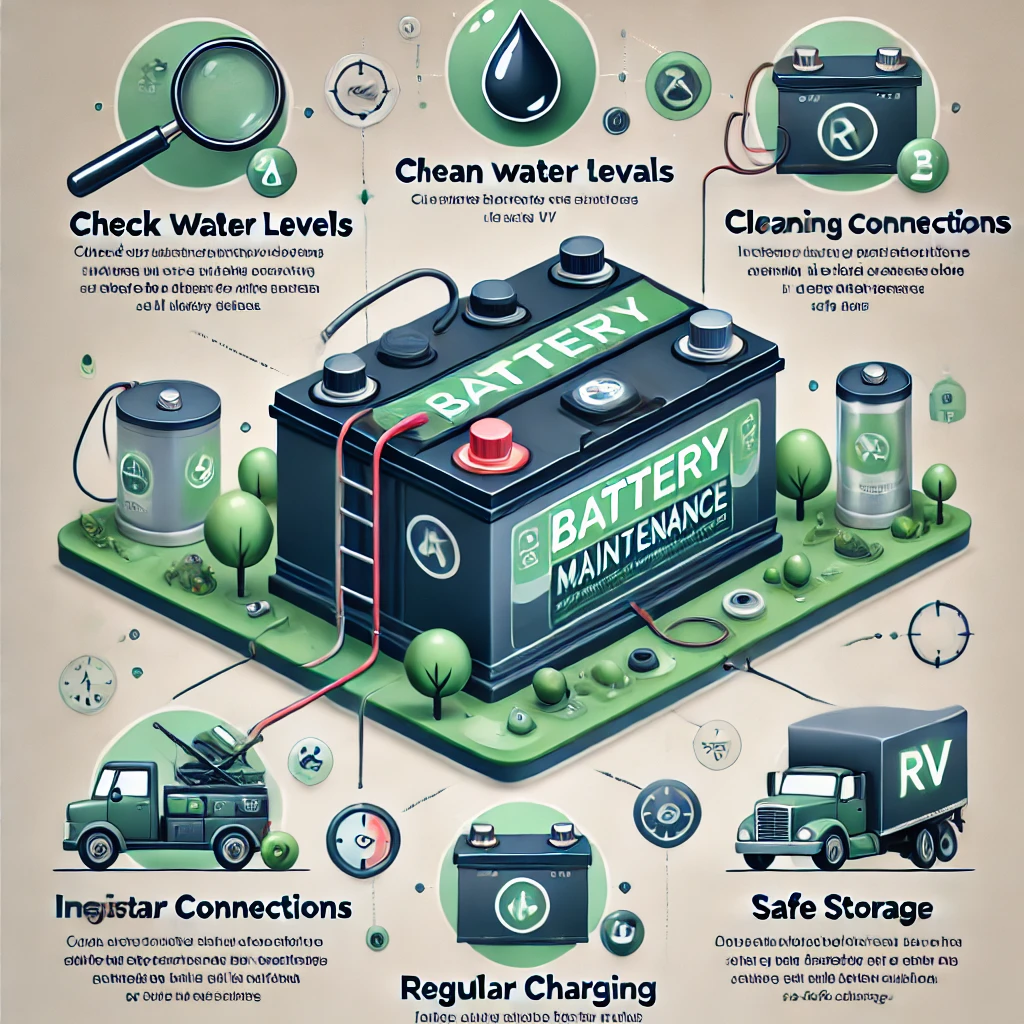
Tips for Extending Battery Lifespan
Avoid Deep Discharges
- Never let battery charge levels drop below 50% (for lead-acid batteries). Lithium-ion batteries can handle deeper discharges but still benefit from regular charging.
Maintain Proper Temperature
- Batteries perform best between 50°F–80°F. Extreme cold or heat can degrade performance, so use insulation or heating pads in harsh climates.
Invest in a Battery Monitor
- A battery monitor helps track real-time charge levels, voltage, and usage, preventing unexpected failures.
RV Battery Safety Precautions: Common Mistakes and How to Overcome Them
RV batteries are essential for powering your motorhome or camper, but mishandling them can lead to accidents, damage, or reduced lifespan. By following safety precautions and avoiding common mistakes, you can ensure safe and efficient use of your RV batteries.
Essential RV Battery Safety Precautions
1. Wear Proper Protective Gear
- Always wear gloves and safety goggles when working on batteries to protect against acid spills and electrical shocks.
- Avoid loose clothing and metal jewelry that could cause accidental short circuits.
2. Ensure Proper Ventilation
- RV batteries, especially lead-acid types, emit hydrogen gas during charging, which is flammable. Always charge batteries in a well-ventilated area to prevent gas buildup.
3. Handle Batteries Carefully
- Lift batteries using proper tools or handles; avoid tipping them, as this can cause acid spills.
- Inspect for cracks or leaks before use to prevent exposure to hazardous materials.
4. Disconnect Safely
- Turn off all power sources and disconnect the negative terminal first to avoid sparks or shocks.
5. Use the Correct Charger
- Match the charger to your battery type (e.g., lithium-ion or lead-acid) to prevent overcharging or overheating.
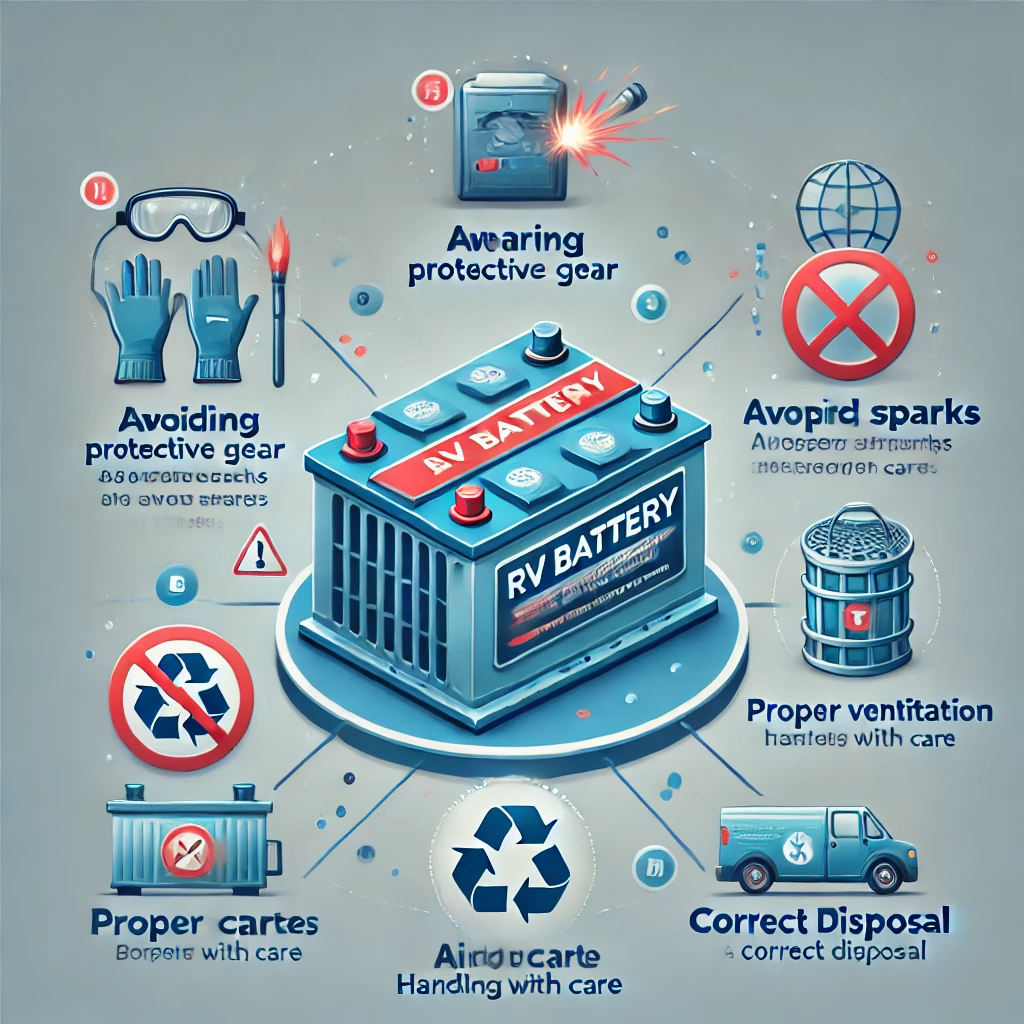
Common RV Battery Mistakes and How to Fix Them

1. Overcharging or Undercharging
- Mistake: Leaving the battery on charge for too long or not charging it enough.
- Solution: Use a smart charger that automatically stops when the battery is full. Regularly monitor charge levels with a battery monitor.
2. Ignoring Maintenance Needs
- Mistake: Failing to check water levels in lead-acid batteries or clean corroded terminals.
- Solution: Schedule routine inspections to refill distilled water and clean terminals with a baking soda solution. Apply dielectric grease to prevent future corrosion.
3. Mixing Battery Types or Ages
- Mistake: Using batteries of different types or ages in the same bank.
- Solution: Always replace batteries as a matched set with identical capacity and age.
4. Storing Batteries Improperly
- Mistake: Leaving batteries unused for extended periods without charging.
- Solution: Store batteries in a cool, dry place and charge them every 1-2 months to maintain their health.
5. Using Incorrect Wiring
- Mistake: Improper wiring can cause short circuits or reduce battery efficiency.
- Solution: Double-check connections and consult your RV manual or a professional for proper wiring diagrams.
6. Failing to Monitor Battery Health
- Mistake: Not tracking voltage levels or ignoring signs of a failing battery.
- Solution: Invest in a battery monitor to detect issues early, such as excessive voltage drops or incomplete charges.
Final Thoughts
RV battery safety begins with understanding proper handling, maintenance, and charging procedures. By avoiding common mistakes like overcharging, neglecting maintenance, or improper storage, you can ensure your batteries operate safely and efficiently. Remember, a little care goes a long way in extending battery life and preventing accidents.
More related details will be available on Flamingo Motorhomes.

